List of French monarchs
| Monarchy of France | |
|---|---|
 | |
 Napoleon III | |
| Details | |
| Style | See article |
| First monarch | Clovis I (as King) |
| Last monarch | Napoleon III (as Emperor) |
| Formation | 486 |
| Abolition | 4 September 1870 |
| Residence | Palais de la Cité Louvre Palace Palace of Versailles Tuileries Palace |
| Appointer | Hereditary |
| Pretender(s) | Disputed: Louis Alphonse (House of Bourbon) Henri d'Orléans (House of Orléans) Jean-Christophe (House of Bonaparte) |
The monarchs of the Kingdom of France and its predecessors ruled from the establishment of the Kingdom of the Franks in 486 until the fall of the Second French Empire in 1870.
Sometimes included as "Kings of France"[1] are the kings of the Franks of the Merovingian dynasty, which ruled from 486 until 751,[2] and of the Carolingians, who ruled until 987 (with some interruptions).
The [[Capetian dynasty]|Carpet Dynasty], the male-line descendants of Huge Carpet, included the first rulers to adopt the title of King of France for the first time with Philip II (r. 1180–1223). The Capetians ruled continuously from 987 to 1792 and again from 1814 to 1848. The branches of the dynasty which ruled after 1328, however, are generally given the specific branch names of Valois (until 1589) and Bourbon (until 1848).
During the brief period when the French Constitution of 1791 was in effect (1791–92) and after the July Revolution in 1830, the style "King of the French" was used instead of "King of France (and Navarre)". It was a constitutional innovation known as popular monarchy which linked the monarch's title to the French people rather than to the possession of the territory of France.[3]
With the House of Bonaparte "Emperors of the French" ruled in 19th century France, between 1804 and 1814, again in 1815 and between 1852 and 1871.
Titles

The title "King of the Franks" (Latin: Rex Francorum) gradually lost ground after 1190, during the reign of Philip II (but FRANCORUM REX continued to be used, for example by Louis XII in 1499, by Francis I in 1515, and by Henry II about 1550. It was used on coins up to the eighteenth century.[n 1] During the brief period when the French Constitution of 1791 was in effect (1791–92) and after the July Revolution in 1830, the style "King of the French" was used instead of "King of France (and Navarre)". It was a constitutional innovation known as popular monarchy which linked the monarch's title to the French people rather than to the possession of the territory of France.[5]
In addition to the Kingdom of France, there were also two French Empires, the first from 1804 to 1814 and again in 1815, founded and ruled by Napoleon I, and the second from 1852 to 1870, founded and ruled by his nephew Napoleon III (also known as Louis-Napoleon). They used the title "Emperor of the French".[6][7]
This article lists all rulers to have held the title "King of the Franks", "King of France", "King of the French" or "Emperor of the French". For other Frankish monarchs, see List of Frankish kings. In addition to the monarchs listed below, the Kings of England and Great Britain from 1340–60, 1369-1420, and 1422–1801 also claimed the title of King of France. For a short time, this had some basis in fact – under the terms of the 1420 Treaty of Troyes, Charles VI had recognized his son-in-law Henry V of England as regent and heir. Henry V predeceased Charles VI and so Henry V's son, Henry VI, succeeded his grandfather Charles VI as King of France. Most of Northern France was under English control until 1435, but by 1453, the English had been expelled from all of France save Calais (and the Channel Islands), and Calais itself fell in 1558. Nevertheless, English and then British monarchs continued to claim the title for themselves until the creation of the United Kingdom in 1801.
Frankish Empire
Merovingian dynasty (486–751)
The Merovingians were a Salian Frankish dynasty that ruled the Franks for nearly 300 years in a region known as Francia in Latin, beginning in the middle of the 5th century. Their territory largely corresponded to ancient Gaul as well as the Roman provinces of Raetia, Germania Superior and the southern part of Germania. The Merovingian dynasty rose to historical prominence with Childeric I (c. 457-481), the son of Merovech, leader of the Salian Franks, but it was his famous son Clovis I (481–511) who united all of Gaul under Merovingian rule.[8]
| Portrait | Name | King from | King until | Death | Relationship with predecessor(s) | Title |
|---|---|---|---|---|---|---|

|
Clovis I |
481 | 511 | Died of natural causes aged 45. Buried at Abbey of St Genevieve until 18th century. Remains relocated to Basilica of St Denis. | • Son of Childeric I, probably grandson of Merovech | King of the Franks (Roi des Francs) |
| After Clovis's death, his kingdom was divided among his four sons, who took up residences in different cities. The number and extent of the parts of the kingdom varied over time. Clothar I, the youngest son, eventually reunited the kingdom. | ||||||

|
Theuderic I (Thierry) |
511 | 533 or 534 | Died 48. | • Eldest son of Clovis I | King of the Franks (Roi des Francs) at Reims |

|
Theudebert I (Thibert) |
533 or 534 | 547 or 548 | Killed in a hunting accident, aged 47. | • Son of Theuderic I | King of the Franks (Roi des Francs) at Reims |
| Theudebald (Thibaut) |
547 or 548 | 555 | Died aged 20. | • Son of Theudebert I | King of the Franks (Roi des Francs) at Reims | |

|
Chlodomer (Chlodomir) |
511 | 25 June 524 | Killed in the Battle of Vézeronce, aged 29. | • Second (surviving) son of Clovis I | King of the Franks (Roi des Francs) at Orléans |
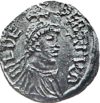
|
Childebert I |
511 | 13 December 558 | Died aged 62. Buried at Abbey of Saint-Germain-des-Prés. | • Third (surviving) son of Clovis I | King of the Franks (Roi des Francs) at Paris |

|
Chlothar the Old (Clotaire) |
511 | 29 November 561 | Died aged 64. Buried at Abbey of St. Medard, Soissons. | • Youngest son of Clovis I | King of the Franks (Roi des Francs) at Soissons |
| After Clothar's death, the kingdom was divided among his four sons. The parts of the kingdom varied over time and eventually developed into three distinct realms. Neustria, centred at Soisson and Paris, Austrasia, centered at Metz, and Burgundy, centered at Orléans. Clothar II, grandson of Clothar I, eventually reunited the kingdom. | ||||||

|
Charibert I (Caribert) |
29 November 561 | 567 | Died aged 50. Buried at Abbey of Saint-Germain-des-Prés. | • Eldest son of Chlothar I | King of the Franks (Roi des Francs) at Paris |
| Guntram (Gontran) |
29 November 561 | 592 | Died aged 60. Buried at Saint Marcellus, Chalon-sur-Saône. | • Second son of Chlothar I | King of the Franks (Roi des Francs) at Orléans | |

|
Sigebert I |
29 November 561 | 575 | Murdered at Vitry-en-Artois, aged 40. | • Third son of Chlothar I | King of the Franks (Roi des Francs) at Metz |
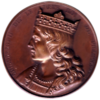
|
Childebert II |
575 | 595 | Died aged 24. | • Son of Sigebert I
• Adopted son of Guntram |
King of the Franks (Roi des Francs) King of Austrasia and (after 592) Burgundy |
| Theudebert II (Thibert) |
595 | 612 | Murdered, aged 26. | • Older son of Childebert II | King of the Franks (Roi des Francs) King of Austrasia | |
| Theuderic II (Thierry) |
595 | 613 | Died, aged 26. | • Younger son of Childebert II | King of the Franks (Roi des Francs) King of Burgundy (595-613) and Austrasia (612-613) | |
| Sigebert II |
613 | 613 | Executed, aged 12. | • Son of Theuderic II | King of the Franks (Roi des Francs) King of Austrasia and Burgundy | |

|
Chilperic I (Chilpéric) |
29 November 561 | 584 | Died aged 45. Buried at Abbey of Saint-Germain-des-Prés. | • Youngest son of Chlothar I | King of the Franks (Roi des Francs) at Soissons |
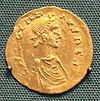
|
Chlothar II the Great, the Young (Clotaire) |
584 | 18 October 629 | Died aged 45. Buried at Abbey of Saint-Germain-des-Prés. | • Son of Chilperic I | King of the Franks (Roi des Francs) at Soissons King of Neustria (595-639) King of Burgundy (613-629) King of Austrasia (613-623) |
| Following the reunification of the kingdom, Neustria and Burgundy remained under the direct rule of the King of the Franks, while Austrasia was soon put under the rule of a junior king. The following list restricts itself to the kings ruling in Neustria and Burgundy. | ||||||
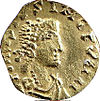
|
Dagobert I | 18 October 629 | 19 January 639 | Died aged 36. Buried at Basilica of St Denis. | • Son of Chlothar II | King of the Franks (Roi des Francs) |

|
Clovis II the Lazy | c. 634 | 31 October 657 | Died aged 23. Buried at Basilica of St Denis. | • Son of Dagobert I | King of Neustria and Burgundy (Roi de Neustrie et de Bourgogne) |
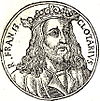
|
Chlothar III (Clotaire) |
31 October 657 | 673 | Died aged 24. Buried at Basilica of St Denis. | • Son of Clovis II | King of Neustria and Burgundy (Roi de Neustrie et de Bourgogne) King of Austrasia (661–662) |

|
Childeric II (Childéric) |
673 | 675 | Died aged 22. Buried at Abbey of Saint-Germain-des-Prés. | • Son of Clovis II • Younger brother of Chlothar III |
King of the Franks (Roi des Francs) |

|
Theuderic III (Thierry) |
675 | 691 | Died aged 37. | • Son of Clovis II • Younger brother of Childeric II |
King of Neustria (Roi de Neustrie) King of the Franks (Roi des Francs) (687–691) |

|
Clovis IV | 691 | 695 | Died aged 13. | • Son of Theuderic III | King of the Franks (Roi des Francs) |
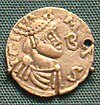
|
Childebert III the Just | 695 | 23 April 711 | Died aged 28. Buried at Church of St Stephen at Choisy-au-Bac, near Compiègne. | • Son of Theuderic III • Younger brother of Clovis IV |
King of the Franks (Roi des Francs) |

|
Dagobert III | 23 April 711 | 715 | Died aged 14. | • Son of Childebert III | King of the Franks (Roi des Francs) |

|
Chilperic II (Chilpéric II) |
715 | 13 February 721 | Died aged 49. Buried at Noyon. | • Probably son of Childeric II | King of Neustria and Burgundy (Roi de Neustrie et de Bourgogne) King of the Franks (Roi des Francs) (719–721) |

|
Theuderic IV | 721 | 737 | Died aged 25. | • Son of Dagobert III | King of the Franks (Roi des Francs) |
| The last Merovingian kings, known as the lazy kings (rois fainéants), did not hold any real political power, while the Mayor of the Palace governed instead. When Theuderic IV died in 737, Mayor of the Palace Charles Martel left the throne vacant and continued to rule until his own death in 741. His sons Pepin and Carloman briefly restored the Merovingian dynasty by raising Childeric III to the throne in 743. In 751, Pepin deposed Childeric and became King in his place. | ||||||

|
Childeric III (Childéric) |
743 | November 751 | Died aged 37. | • Son of Chilperic II or of | King of the Franks (Roi des Francs) |
Carolingian dynasty (751–888)
The Carolingian dynasty was a Frankish noble family with origins in the Arnulfing and Pippinid clans of the 7th century AD. The family consolidated its power in the late 8th century, eventually making the offices of mayor of the palace and dux et princeps Francorum hereditary and becoming the real powers behind the Merovingian kings. In 751, a Carolingian, Pepin the Younger, dethroned the Merovingians and with the consent of the Papacy and the aristocracy, was crowned King of the Franks.[9]
| Portrait | Name | King from | King until | Death | Relationship with predecessor(s) | Title |
|---|---|---|---|---|---|---|
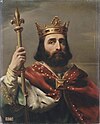
|
Pepin the Short | 751 | 24 September 768 | • Son of Charles Martel and Rotrude of Hesbaye, a maternal granddaughter of Theuderic III | King of the Franks | |
| Carloman I | 24 September 768 | 4 December 771 | • Son of Pepin | King of the Franks | ||

|
Charles I the Great Charlemagne |
24 September 768 | 28 January 814 | • Son of Pepin | King of the Franks Emperor of the Romans | |

|
Louis I the Pious | 28 January 814 | 20 June 840 | • Son of Charlemagne | King of the Franks Emperor of the Romans | |

|
Charles II the Bald | 20 June 840 | 6 October 877 | • Son of Louis I | King of the Franks Emperor of the Romans (875–77) | |

|
Louis II the Stammerer | 6 October 877 | 10 April 879 | • Son of Charles II | King of the Franks | |

|
Louis III | 10 April 879 | 5 August 882 | • Son of Louis II | King of the Franks | |

|
Carloman II | 5 August 882 | 6 December 884 | • Son of Louis II | King of the Franks | |
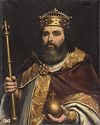
|
Charles III the Fat | 20 May 885 | 13 January 888 | • Son of Louis the German • Cousin of Louis II and Carloman II • Grandson of Louis I |
King of the Franks Emperor of the Romans (881–87) |
Robertian dynasty (888–898)
The Robertians were Frankish noblemen owing fealty to the Carolingians, and ancestors of the subsequent Capetian dynasty. Odo, Count of Paris, was chosen by the western Franks to be their king following the removal of emperor Charles the Fat. He was crowned at Compiègne in February 888 by Walter, Archbishop of Sens.[10]
| Portrait | Name | King from | King until | Relationship with predecessor(s) | Title |
|---|---|---|---|---|---|
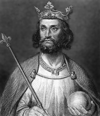
|
Odo of Paris (Eudes) |
29 February 888 | 1 January 898 | • Son of Robert the Strong (Robertians) • Elected king against young Charles III. |
King of the Franks (Roi des Francs) |
Carolingian dynasty (893–922)
Charles, the posthumous son of Louis II, was crowned by a faction opposed to the Robertian Odo at Reims Cathedral, though he only became the effectual monarch with the death of Odo in 898.[11]
| Portrait | Name | King from | King until | Relationship with predecessor(s) | Title |
|---|---|---|---|---|---|
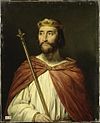
|
Charles III the Simple | 28 January 898 | 30 June 922 | • Posthumous son of Louis II • Younger half-brother of Louis III and Carloman II |
King of the Franks (Roi des Francs) |
Robertian dynasty (922–923)
| Portrait | Name | King from | King until | Relationship with predecessor(s) | Title |
|---|---|---|---|---|---|

|
Robert I | 30 June 922 | 15 June 923 | • Son of Robert the Strong (Robertians) • Younger brother of Odo |
King of the Franks (Roi des Francs) |
Bosonid dynasty (923–936)
The Bosonids were a noble family descended from Boso the Elder, their member, Rudolph (Raoul), was elected "King of the Franks" in 923.
| Portrait | Name | King from | King until | Relationship with predecessor(s) | Title |
|---|---|---|---|---|---|
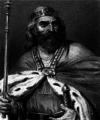
|
Rudolph (Raoul) |
13 July 923 | 14 January 936 | • Son of Richard, Duke of Burgundy (Bosonids) • Son-in-law of Robert I |
King of the Franks (Roi des Francs) |
Carolingian dynasty (936–987)
| Portrait | Name | King from | King until | Relationship with predecessor(s) | Title |
|---|---|---|---|---|---|

|
Louis IV of Outremer | 19 June 936 | 10 September 954 | • Son of Charles III | King of the Franks (Roi des Francs) |

|
Lothair | 12 November 954 | 2 March 986 | • Son of Louis IV | King of the Franks (Roi des Francs) |
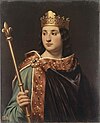
|
Louis V | 8 June 986 | 22 May 987 | • Son of Lothair | King of the Franks (Roi des Francs) |
Capetian dynasty (987–1792)
After the death of Louis V, the son of Hugh the Great and grandson of Robert I, Hugh Capet, was elected by the nobility as king of France. The Capetian Dynasty, the male-line descendants of Hugh Capet, ruled France continuously from 987 to 1792 and again from 1814 to 1848. They were direct descendants of the Robertian kings. The cadet branches of the dynasty which ruled after 1328, however, are generally given the specific branch names of Valois and Bourbon.
Not listed below are Hugh Magnus, eldest son of Robert II, and Philip of France, eldest son of Louis VI; both were co-kings with their fathers (in accordance with the early Capetian practice whereby kings would crown their heirs in their own lifetimes and share power with the co-king), but predeceased them. Because neither Hugh nor Philip were sole or senior king in their own lifetimes, they are not traditionally listed as Kings of France, and are not given ordinals.
Henry VI of England, son of Catherine of Valois, became titular King of France upon his grandfather Charles VI's death in accordance with the Treaty of Troyes of 1420; however this was disputed and he is not always regarded as a legitimate king of France. English claims to the French throne actually date from 1328, when Edward III claimed the throne after the death of Charles IV. Other than Henry VI, none had ever had their claim backed by treaty, and his title became contested after 1429, when Charles VII was crowned. Henry himself was crowned by a different faction in 1431, though at the age of 9, he had yet to come of age. The final phase of the Hundred Years War was fought between these competing factions, resulting in a Valois victory at the Battle of Castillon in 1453, putting an end to any meaningful claims of the English monarchs over the throne of France, though English (and later British) monarchs would continue to use the title "King of France" until 1801.
From 21 January 1793 to 8 June 1795, Louis XVI's son Louis-Charles was the titular King of France as Louis XVII; in reality, however, he was imprisoned in the Temple throughout this duration, and power was held by the leaders of the Republic. Upon Louis XVII's death, his uncle (Louis XVI's brother) Louis-Stanislas claimed the throne, as Louis XVIII, but only became de facto King of France in 1814.
Direct Capetians (987–1328)
The main line of descent from Hugh Capet is generally known as the "direct Capetians". This line became extinct in 1328, precipitating a succession crisis known as the Hundred Years War. While there were numerous claimants to succeed, the two best claimants were the House of Valois and the House of Plantagenet.
| Portrait | Coat of arms | Name | King from | King until | Relationship with predecessor(s) | Title |
|---|---|---|---|---|---|---|
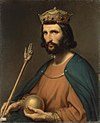 |
Hugh Capet | 3 July 987 | 24 October 996 | • Grandson of Robert I | King of the Franks (Roi des Francs) | |
 |
Robert II the Pious, the Wise | 24 October 996 | 20 July 1031 | • Son of Hugh Capet | King of the Franks (Roi des Francs) | |
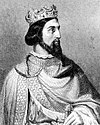 |
Henry I (Henri) |
20 July 1031 | 4 August 1060 | • Son of Robert II | King of the Franks (Roi des Francs) | |
 |
Philip I the Amorous (Philippe) |
4 August 1060 | 29 July 1108 | • Son of Henry I | King of the Franks (Roi des Francs) | |
 |
Louis VI the Fat | 29 July 1108 | 1 August 1137 | • Son of Philip I | King of the Franks (Roi des Francs) | |
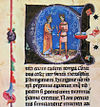 |
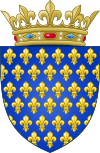 |
Louis VII the Young | 1 August 1137 | 18 September 1180 | • Son of Louis VI | King of the Franks (Roi des Francs) |
 |
 |
Philip II Augustus (Philippe Auguste) |
18 September 1180 | 14 July 1223 | • Son of Louis VII | King of the Franks (Roi des Francs) King of France (Roi de France) |
 |
 |
Louis VIII the Lion | 14 July 1223 | 8 November 1226 | • Son of Philip II Augustus | King of France (Roi de France) |
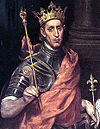 |
 |
Louis IX the Saint (Saint Louis) |
8 November 1226 | 25 August 1270 | • Son of Louis VIII | King of France (Roi de France) |
 |
 |
Philip III the Bold (Philippe) |
25 August 1270 | 5 October 1285 | • Son of Louis IX | King of France (Roi de France) |
 |
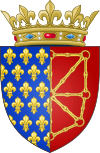 |
Philip IV the Fair, the Iron King (Philippe) |
5 October 1285 | 29 November 1314 | • Son of Philip III | King of France and of Navarre (Roi de France et de Navarre) |
| File:Louis X Le Hutin.jpg |  |
Louis X the Quarreller | 29 November 1314 | 5 June 1316 | • Son of Philip IV | King of France and of Navarre (Roi de France et de Navarre) |
 |
 |
John I the Posthumous (Jean) |
15 November 1316 | 20 November 1316 | • Son of Louis X | King of France and of Navarre (Roi de France et de Navarre) |
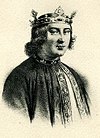 |
 |
Philip V the Tall (Philippe) |
20 November 1316 | 3 January 1322 | • Son of Philip IV • Younger brother of Louis X |
King of France and of Navarre (Roi de France et de Navarre) |
 |
 |
Charles IV the Fair | 3 January 1322 | 1 February 1328 | • Son of Philip IV • Younger brother of Louis X and Philip V |
King of France and of Navarre (Roi de France et de Navarre) |
House of Valois (1328–1589)
The death of the last Direct Capetian precipitated the Hundred Years' War between the House of Valois and the House of Plantagenet over control of the French throne.[12] The Valois claimed the right to the succession by male-only primogeniture, having the closest all-male line of descent from a recent French king. They were descended from the third son of Philip III, Charles, Count of Valois. The Plantagenets based their claim on being closer to a more recent French King, Edward III of England being a grandson of Philip IV through his mother, Isabella. The two houses fought the Hundred Years War to enforce their claims; the Valois were ultimately successful, and French historiography counts their leaders as rightful kings. One Plantagenet, Henry VI of England, did enjoy de jure control of the French throne under the terms of the Treaty of Troyes, which formed the basis for continued English claims to the throne of France until the 19th century. The Valois line would rule France until the line became extinct in 1589, in the backdrop of the French Wars of Religion. As Navarre did not have a tradition of male-only primogeniture, the Navarrese monarchy became distinct from the French, with Joan II, a daughter of Louis X, inheriting there.
| Portrait | Coat of arms | Name | King from | King until | Relationship with predecessor(s) | Title |
|---|---|---|---|---|---|---|
 |
 |
Philip VI the Fortunate (Philippe) |
1 April 1328 | 22 August 1350 | • Grandson of Philip III of France | King of France (Roi de France) |
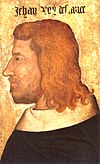 |
 |
John II the Good (Jean) |
22 August 1350 | 8 April 1364 | • Son of Philip VI | King of France (Roi de France) |
 |
  |
Charles V the Wise | 8 April 1364 | 16 September 1380 | • Son of John II | King of France (Roi de France) |
 |
 |
Charles VI the Beloved, the Mad | 16 September 1380 | 21 October 1422 | • Son of Charles V | King of France (Roi de France) |
House of Lancaster (1422–1453) (disputed)
| Portrait | Coat of arms | Name | King from | King until | Claim | Title |
|---|---|---|---|---|---|---|
 |
 |
Henry VI of England (Henri VI d'Angleterre) |
21 October 1422 | 19 October 1453 | By right of his father Henry V of England, who by the Treaty of Troyes became heir and regent of France. Grandson of Charles VI of France. | King of France (Roi de France) |
House of Valois (1328–1589)
| Portrait | Coat of arms | Name | King from | King until | Relationship with predecessor | Title |
|---|---|---|---|---|---|---|
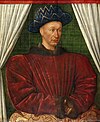 |
 |
Charles VII the Victorious, the Well-Served | 21 October 1422 | 22 July 1461 | • Son of Charles VI • Uncle of Henry VI of England |
King of France. (Roi de France) |
 |
 |
Louis XI the Prudent, the Cunning, the Universal Spider | 22 July 1461 | 30 August 1483 | • Son of Charles VII | King of France (Roi de France) |
 |
 |
Charles VIII the Affable | 30 August 1483 | 7 April 1498 | • Son of Louis XI | King of France (Roi de France) |
 |
 |
Louis XII Father of the People | 7 April 1498 | 1 January 1515 | • Great-grandson of Charles V • Second cousin, and by first marriage son-in-law of Louis XI • By second marriage husband of Anne of Brittany, widow of Charles VIII |
King of France (Roi de France) |
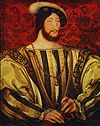 |
 |
Francis I the Father and Restorer of Letters (François) |
1 January 1515 | 31 March 1547 | • Great-great-grandson of Charles V • First cousin once removed, and by first marriage son-in-law of Louis XII |
King of France (Roi de France) |
 |
 |
Henry II (Henri) |
31 March 1547 | 10 July 1559 | • Son of Francis I/Maternal grandson of Louis XII | King of France (Roi de France) |
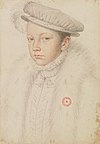 |
 |
Francis II (François) |
10 July 1559 | 5 December 1560 | • Son of Henry II | King of France (Roi de France) King of Scots (1558–1560) |
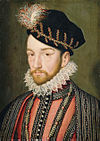 |
 |
Charles IX | 5 December 1560 | 30 May 1574 | • Son of Henry II | King of France (Roi de France) |
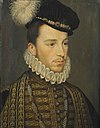 |
 |
Henry III (Henri) |
30 May 1574 | 2 August 1589 | • Son of Henry II | King of France (Roi de France) King of Poland and Grand Duke of Lithuania (1573–1575) |
House of Bourbon (1589–1792)
The Valois line looked strong on the death of Henry II, who left four male heirs. His first son, Francis II, died in his minority. His second son, Charles IX, had no legitimate sons to inherit. Following the assassination of his third son, the childless Henry III, and the premature death of his fourth son Francis, Duke of Anjou, France was plunged into a succession crisis over which distant cousin of the king would inherit the throne. The best claimant, King Henry III of Navarre, was a Protestant, and thus unacceptable to much of the French nobility. Ultimately, after winning numerous battles in defense of his claim, Henry converted to Catholicism and was crowned king, founding the House of Bourbon. This marked the second time the thrones of Navarre and France were united under one monarch; as different inheritance laws had caused them to become separated during the events of the Hundred Years Wars.
| Portrait | Coat of arms | Name | King from | King until | Relationship with predecessor(s) | Title |
|---|---|---|---|---|---|---|
 |
 |
Henry IV the Green Gallant Good King Henry (Henri) |
2 August 1589 | 14 May 1610 | • Tenth generation descendant of Louis IX in the male line • By first marriage son in law of Henry II, Brother in law of Francis II, Charles IX and Henry III |
King of France and of Navarre (Roi de France et de Navarre) |
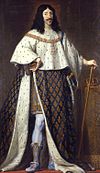 |
 |
Louis XIII the Just | 14 May 1610 | 14 May 1643 | • Son of Henry IV | King of France and of Navarre (Roi de France et de Navarre) |
 |
 |
Louis XIV the Great the Sun King | 14 May 1643 | 1 September 1715 | • Son of Louis XIII | King of France and of Navarre (Roi de France et de Navarre) |
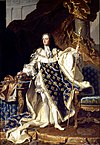 |
 |
Louis XV the Beloved |
1 September 1715 | 10 May 1774 | • Great-grandson of Louis XIV | King of France and of Navarre (Roi de France et de Navarre) |
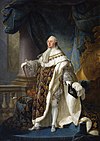 |
 |
Louis XVI the Restorer of French Liberty | 10 May 1774 | 21 September 1792 | • Grandson of Louis XV | King of France and of Navarre (Roi de France et de Navarre) (1774–1791) King of the French (Roi des Français) (1791–1792) |
 |
 |
Louis XVII (Claimant) |
21 January 1793 | 8 June 1795 | • Son of Louis XVI | (Disputed) King of France and of Navarre (Roi de France et de Navarre) |
House of Bonaparte, First Empire (1804–1814)
The French First Republic lasted from 1792 to 1804, when its First Consul, Napoléon Bonaparte, was declared Emperor of the French.
| Portrait | Coat of arms | Name | Emperor from | Emperor until | Relationship with predecessor(s) | Title |
|---|---|---|---|---|---|---|
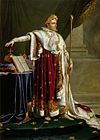 |
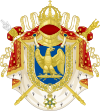 |
Napoleon I the Great (Napoléon) |
18 May 1804 | 11 April 1814 | Husband of a first cousin once removed of Louis XVII. | Emperor of the French (Empereur des Français) |
Capetian Dynasty (1814–1815)
Following the first defeat of Napoleon and his exile to Elba, the Bourbon monarchy was restored, with Louis XVI's younger brother Louis Stanislas being crowned as Louis XVIII. Louis XVI's son had been considered by monarchists as Louis XVII but he was never crowned and never ruled in his own right before his own death; he is not usually counted among French monarchs, creating a gap in numbering on most traditional lists of French kings. Napoleon would briefly regain control of the country during his Hundred Days rule in 1815. After his final defeat at the Battle of Waterloo, Napolean attempted to abdicate in favor of his son, but the Bourbon Monarchy was re-established yet again, and would continue to rule France until the July Revolution of 1830 replaced it with a cadet branch, the House of Orleans.
House of Bourbon, Bourbon Restoration (1814–1815)
| Portrait | Coat of arms | Name | King from | King until | Relationship with predecessor(s) | Title |
|---|---|---|---|---|---|---|
 |
 |
Louis XVIII the Desired | 11 April 1814 | 20 March 1815 | • Grandson of Louis XV • Younger Brother of Louis XVI • Brother-in-law of Napoleon I's wife's great-aunt. | King of France and of Navarre (Roi de France et de Navarre) |
House of Bonaparte, First Empire (Hundred Days, 1815)
| Portrait | Coat of arms | Name | Emperor from | Emperor until | Relationship with predecessor(s) | Title |
|---|---|---|---|---|---|---|
 |
 |
Napoleon I the Great (Napoléon) |
20 March 1815 | 22 June 1815 | Husband of a grandniece of a sister-in law of Louis XVIII | Emperor of the French (Empereur des Français) |
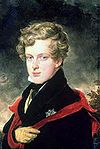 |
 |
Napoleon II the Eaglet (Napoléon) [n 2] |
22 June 1815 | 7 July 1815 | • Son of Napoleon I | (Disputed) Emperor of the French (Empereur des Français) |
Capetian Dynasty (1815–1848)
House of Bourbon (1815–1830)
| Portrait | Coat of arms | Name | King from | King until | Relationship with predecessor(s) | Title |
|---|---|---|---|---|---|---|
 |
 |
Louis XVIII the Desired | 7 July 1815 | 16 September 1824 | • Grandson of Louis XV • Younger Brother of Louis XVI | King of France and of Navarre (Roi de France et de Navarre) |
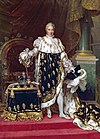 |
 |
Charles X | 16 September 1824 | 2 August 1830 | • Grandson of Louis XV • Younger Brother of Louis XVI and Louis XVIII | King of France and of Navarre (Roi de France et de Navarre) |
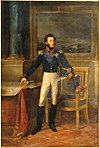 |
 |
Louis XIX Antoine | 2 August 1830 | 2 August 1830 (20 minutes) |
• Son of Charles X | (Disputed) King of France and of Navarre (Roi de France et de Navarre) |
 |
 |
Henry V (Henri) |
2 August 1830 | 9 August 1830 (7 days) |
• Grandson of Charles X • Nephew of Louis Antoine |
(Disputed) King of France and of Navarre (Roi de France et de Navarre) |
House of Orléans, July Monarchy (1830–1848)
The Bourbon restoration came to an end with the July Revolution of 1830, which deposed Charles X and replaced him with Louis Philippe I, a distant cousin with more liberal politics. The popular monarchy changed the styles and forms of the ancien regime, replacing it with more populist forms (i.e. replacing "King of France" with "King of the French"). Ultimately it was overthrown as well during the continent-wide Revolutions of 1848, to be replaced by the Second French Republic.
| Portrait | Coat of arms | Name | King from | King until | Relationship with predecessor(s) | Title |
|---|---|---|---|---|---|---|
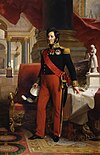 |
 |
Louis-Philippe I the Citizen King | 9 August 1830 | 24 February 1848 | • Sixth generation descendant of Louis XIII in the male line • Fifth cousin of Louis XVI, Louis XVIII and Charles X |
King of the French (Roi des Français) |
House of Bonaparte, Second Empire (1852–1870)
The Second French Republic lasted from 1848 to 1852, when its president, Louis-Napoléon Bonaparte, was declared Emperor of the French.
When he was declared emperor, Louis-Napoleon Bonaparte took the regnal name Napoleon III, after his uncle (the Emperor Napoleon I) and his cousin (Napoleon II, who was declared but uncrowned as heir to the Imperial throne). He would later be overthrown during the events of the Franco-Prussian war. He was the last monarch to rule France; thereafter the country was ruled by a succession of Republican governments. (See French Third Republic.)
| Portrait | Coat of arms | Name | Emperor from | Emperor until | Relationship with predecessor(s) | Title |
|---|---|---|---|---|---|---|
 |
 |
Napoleon III (Napoléon) |
2 December 1852 | 4 September 1870 | • Nephew of Napoleon I | Emperor of the French (Empereur des Français) |
Later pretenders
Various pretenders descended from the preceding monarchs have claimed to be the legitimate monarch of France, rejecting the claims of the President of France, and of each other. These groups are:
- Legitimist claimants to the throne of France: descendants of the Bourbons, rejecting all heads of state 1792–1814, 1815, and since 1830. Unionists recognized the Orléanist claimant after 1883.
- Legitimist-Anjou claimants to the throne of France: descendants of Louis XIV, claiming precedence over the House of Orléans by virtue of primogeniture
- Orléanist claimants to the throne of France: descendants of Louis-Phillippe, himself descended from a junior line of the Bourbon dynasty, rejecting all heads of state since 1848.
- Bonapartist claimants to the throne of France: descendants of Napoleon I and his brothers, rejecting all heads of state 1815–48, and since 1870.
- English claimaints to the throne of France: Kings of England and later, of Great Britain (renounced by Hanoverian King George III upon union with Ireland in 1800).
- Jacobite claimants to the throne of France: senior heirs-general of King Edward III of England and thus his claim to the French throne, also claiming England, Scotland, and Ireland.
See also
- Kings of France family tree (detailed)
- French monarchs family tree (simple)
- Style of the French sovereign
- British claims to the French throne
- List of French consorts
- List of heirs to the French throne
Notes
- ^ 'Louis XII, 1499 [...] LVDOVIVS XII FRANCORUM REX MEDILANI DUX [...] Francis I, 1515 [...] FRANCISCUS REX FRANCORUM PRIMUS DOMINATOR ELVETIORUM [...] Henri II, 1550? [...] HENRICVS II FRANCORVM REX' [4]
- ^ From 22 June to 7 July 1815, Bonapartists considered Napoleon II as the legitimate heir to the throne, his father having abdicated in his favor. However, throughout this period he resided in Austria, with his mother. Louis XVIII was reinstalled as king on 7 July.
References
- ^ Sullivan, William. Historical causes and effects, from the fall of the Roman empire, 476, to the reformation, 1517. p. 213. Grimshaw, William. The history of France from the foundation of the monarchy to the death of Louis XVI. p. 11
- ^ Claudio Rendina & Paul McCusker, The Popes: Histories and Secrets, (New York : 2002), p. 145.
- ^ Deploige, Jeroen; Deneckere, Gita, eds. (2006). Mystifying the Monarch: Studies on Discourse, Power, and History. Amsterdam, Netherlands: Amsterdam University Press. p. 182. ISBN 9789053567678.
- ^ Potter, David (2008). Renaissance France at War: Armies, Culture and Society, C.1480–1560. Warfare in History Series. Vol. 28. Boydell & Brewer Ltd. p. viii. ISBN 9781843834052. Retrieved 27 November 2012.
- ^ Deploige, Jeroen; Deneckere, Gita, eds. (2006). Mystifying the Monarch: Studies on Discourse, Power, and History. Amsterdam, Netherlands: Amsterdam University Press. p. 182. ISBN 9789053567678.
- ^ Le Couronnement de Napoléon Premier, Empereur des Français. Paris, France: Guerin. 1806. p. 1.
- ^ Pascal, Adrien (1853). Histoire de Napoléon III, Empereur des Français. Paris, France: Barbier. p. 359.
- ^ Brown, Peter (2003). The Rise of Western Christendom. Malden, MA, USA: Blackwell Publishing Ltd. p. 137.
- ^ Babcock, Philip (1993). Webster's Third New International Dictionary of the English Language, Unabridged. MA, USA: Merriam-Webster. p. 341.
- ^ Gwatking, H. M.; Whitney, J. P.; et al. (1930). Cambridge Medieval History: Germany and the Western Empire. Vol. Volume III. London: Cambridge University Press.
{{cite book}}:|volume=has extra text (help) - ^ Parisse, Michael (2005). "Lotharingia". In Reuter, T. (ed.). The New Cambridge Medieval History: c. 900–c. 1024. Vol. III. Cambridge, UK: Cambridge University Press. pp. 313–315.
- ^ Knecht, Robert (2004). The Valois: Kings of France 1328–1422. NY, USA: Hambledon Continuum. pp. ix–xii. ISBN 1852854200.
- Hansen, M.H., ed. (1967). Kings, Rulers, and Statesmen. NY, USA: Sterling Publishing Co., Inc. pp. 103–107.[unreliable source?]
